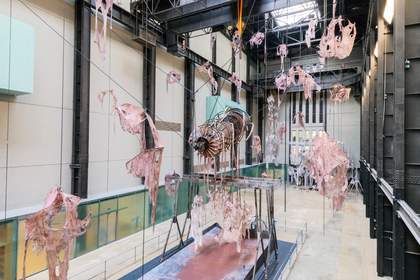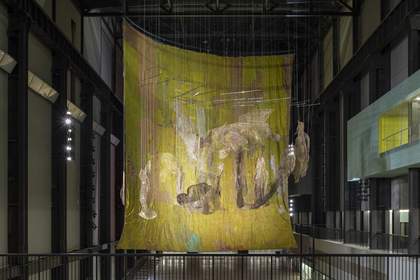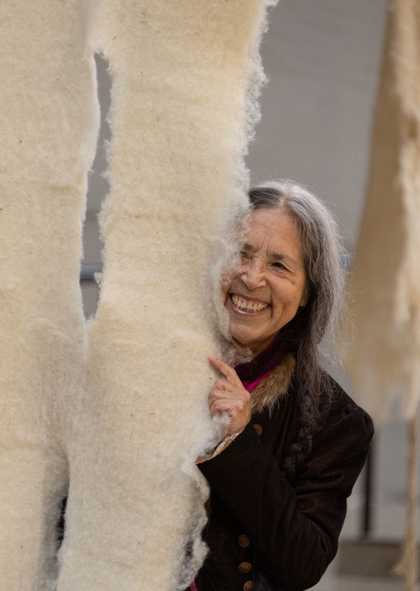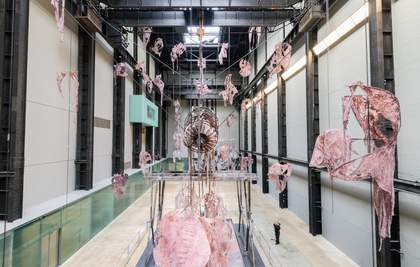
Hyundai Commission: Mire Lee: Open Wound, Installation View. Photo © Tate (Lucy Green)
Ultimately, I am interested in how behind all human actions there is something soft and vulnerable such as sincerity, hope, compassion, love, and wanting to be loved.
Mire Lee
Mire Lee’s Hyundai Commission reimagines Tate Modern as an industrial womb. Reflecting on the building’s former life as a power station, Open Wound presents the Turbine Hall as a living factory, finding human dreams and desires in sprawling mechanical systems.
Lee populates the Turbine Hall with ‘skins’, fabric sculptures that hang from the ceiling on metal chains. At the centre of the Hall's east end, suspended from a ceiling crane, a motorised turbine slowly spins. It discharges a viscous liquid from flesh-like silicone tentacles into a large tray. As the factory runs, new skins are wetted under the turbine, then moved by technicians to harden on nearby racks before being hauled into the air. Over time they will accumulate, ‘birthed’ from the body of the building while appearing to ‘shed’ from the ceiling above. A process of production and decay plays out, facilitated by both machinery and human hands.
For Lee, the complex histories of industry are awe-inspiring in their violence and scale. Her work considers the physical and emotional labour of people living in times of precarity and decline; ‘witnessing a human, an individual life, getting caught in a larger system.’ Concerned with industrial experience both past and present, Open Wound invites us to revel in contradictory emotions: from awe and disgust to compassion, fear and love.
What does it feel like to be haunted by an industrial past?
Lee’s factory is a collage of moments from industrial history. The drying of the fabric ‘skins’ recalls processes from textile manufacturing. Their chain hangings are inspired by pit-head baths, early group washing facilities used by coal miners. A pulley system allowed miners to hang their street or work clothes from the bath house’s ceiling while they laboured in the mines or rested at home. Generations of workers gathered in these transitory spaces to wash away dirt, pain and fatigue.
Tate Modern occupies the site of the former Bankside Power Station. From 1891 to 1981, the Turbine Hall housed coal and oil-fired boilers that generated electricity for London. Lee's installation activates dormant parts of the building, as if waking up ghosts of the industrial past. A large ceiling crane is put back into use, and the cladding on either side of the bridge is removed to allow a glimpse into the wiring or ‘guts’ of the industrial body.
During the industrial revolution workers laboured together in dangerous conditions, slowly replacing themselves with machines. While soaking in these histories, Lee’s skins also suggest the production of new bodies, experiences and identities in the present. She highlights Tate Modern’s industrial past as a power station to ask: what is it that the museum generates today?

Hyundai Commission: Mire Lee: Open Wound, Installation View. Photo © Tate (Lucy Green)
When do individuals become rendered anonymous?
Open Wound explores thresholds and transitions: between human and machine, soft and hard, inside and outside, old and new, familiar and uncanny, individual and collective.
Lee is interested in the ways that industrial-grade machinery can assume surprisingly human qualities. A motor’s internal operation might resemble that of a stomach, while the workings of a pump involve intestine-like pipes. Lee explores this tension between soft organic forms and rigid mechanical systems through her use of materials. Her kinetic sculptures resemble organisms and machines turned inside-out, inner workings of silicone tubes and low-tech motors exposed to unsettling effect. In the east end of the Hall, Lee’s convulsing turbine appears as ‘an open wound that never closes.’ Rejecting the clean, sterile feel of modern technologies, we find ourselves instead in ‘the time of decline.’
Skin is a membrane separating inside and outside, the container of our individual forms. Lee’s fabric ‘skins’ suggest dissolved or malleable bodies. Differing only in size, the suspended hangings also speak to the shared nature of our fleshy existence. Lee observes: ‘I’ve always been interested in skin because it’s something that registers otherness. In this commission, the skins are also about the tensions between individual and collective.’
Why does it sometimes hurt to love?
Lee believes ‘being moved is the strongest thing you can experience through art.’ Reflecting on our current historical moment, Open Wound conjures ‘the mood of a deserted construction site’, an atmosphere of ‘futility and melancholy, where something has started to wither.’ Despite this, the collective ‘skins’ of the living factory suggest an eerie solidarity. They mutate the Hall into an intimate space of ‘dream and distant memory’, in which such feelings can be shared.
Emotions are conflicting, irrational, and frequently destructive. They can also be liberating and restorative. To Lee, our everyday lives are often emotionally incoherent. She draws from the work of feminist and queer artists and thinkers such as the South Korean poet Kim Eon Hee (b.1953) to assert the transformative value of recognising our fundamental passions and vulnerabilities. Lee challenges us to embrace fear and pain alongside hope, so that we might better endure and cherish our precarious lives.
We live in an age where the technologies that connect us also threaten to alienate, divide and harm. Open Wound might evoke contradictory feelings, from tender horror to anxiety or even ambivalence. It is a theatre of a turbulent world, leaking and regurgitating. How do we come together? What can we let go?
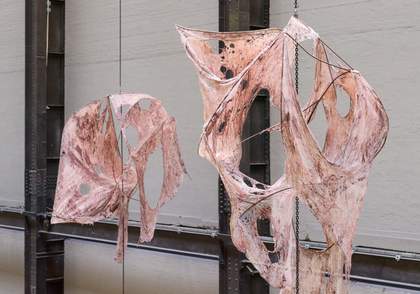
Hyundai Commission: Mire Lee: Open Wound, Installation View. Photo © Tate (Oliver Cowling with Lucy Green)
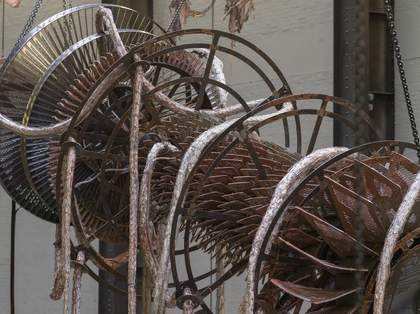
Hyundai Commission: Mire Lee: Open Wound, Installation View. Photo © Tate (Oliver Cowling with Lucy Green)
Audio Description
Listen to an in-depth visual description of Mire Lee’s Hyundai Commission, Open Wound.
Audio Description written by Lonny Evans - Edited by Sally Booth for VocalEyes
Hyundai Commission: Mire Lee Audio Content supported by Bloomberg Philanthropies
About Mire Lee
Mire Lee’s sculptures and environments seek to provide deeply felt experiences. Finding beauty in the grotesque, her work operates on a bodily level and stimulates the senses directly.
Using liquids, chains, clay, silicone hoses and steel frameworks, Lee constructs mechanised organisms made of interdependent parts. Motorised elements are intentionally crude and low-tech, seemingly straining to function. When working, Lee notes: ‘ideas often come from materials; if they come from my head, then they tend to be more abstract. The process itself is the work for me – material discoveries or accidents in the studio.’
Lee’s work probes human hopes and fears surrounding technological progress. She exposes the tensions between popular fantasies of an automated future and the unavoidable decay of matter over time. What results is an artistic practice of animated assemblages which appear in a constantly deferred state of breaking down.
Mire Lee was born in Seoul, South Korea in 1988. She currently lives and works from Seoul, South Korea and Amsterdam, the Netherlands.
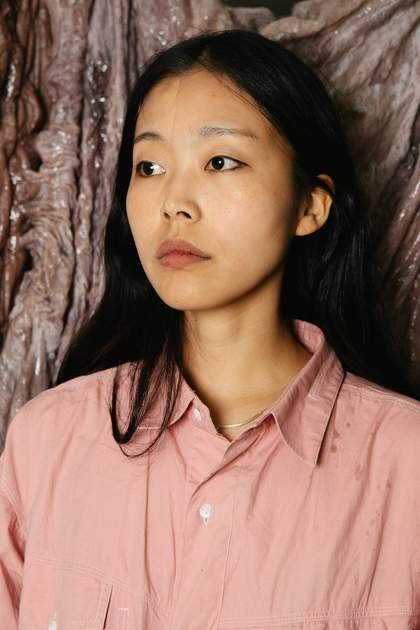
Hyundai Commission: Mire Lee In partnership with Hyundai Motor
Curated by Alvin Li, Curator, International Art, supported by Asymmetry Art Foundation and Bilal Akkouche, Assistant Curator, Tate Modern. Produced by Nancy Cooper, Production Manager

